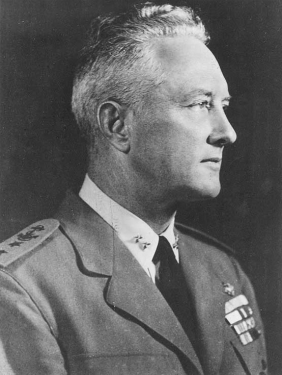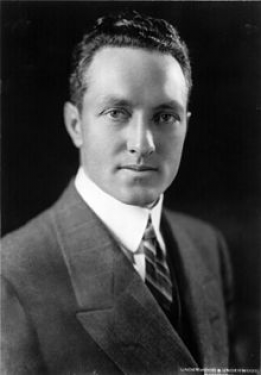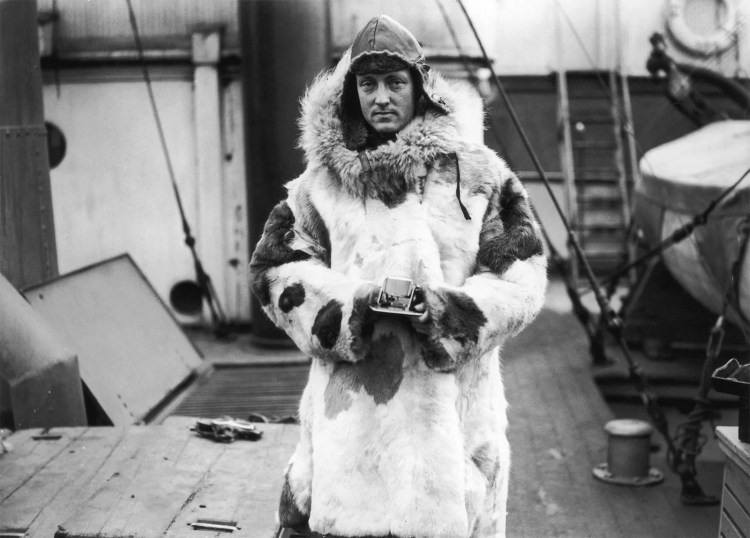
 |
|
|
||
|
Richard Evelyn Byrd, Jr. |
||||
|
Graduate, U.S. Naval Academy, Class of 1916 Engagements: • World War I (1914 - 1918)• World War II (1941 - 1945) |
||||
| Biography: | ||||
|
Richard Evelyn Byrd, Jr. Richard Evelyn Byrd, Jr. was a U.S. Navy officer who specialized in feats of exploration. He was a pioneering American aviator, polar explorer, and organizer of polar logistics. Aircraft flights in which he served as a navigator and expedition leader, crossed the Atlantic Ocean, a segment of the Arctic Ocean, and a segment of the Antarctic Plateau. Byrd claimed that his expeditions had been the first to reach the North Pole and the South Pole by air. His South Pole claim is generally supported by a consensus of those who have examined the evidence. Byrd was a recipient of the Medal of Honor, the U.S. military's highest award for valor. Byrd was born on 25 October 1888 in Winchester, VA, the son of Esther Bolling Flood Byrd and Richard Evelyn Byrd, Sr. He was a descendant of one of the First Families of Virginia. His ancestors include planter John Rolfe and his wife Pocahontas; William Byrd II of Westover Plantation, who established Richmond; and Robert "King" Carter, a colonial governor. He was the brother of Virginia Governor and U.S. Senator Harry F. Byrd, a dominant figure in the Virginia Democratic Party between the 1920s and 1960s; their father served as Speaker of the Virginia House of Delegates for a time. On 20 January 1915, Byrd married Marie Donaldson Ames (he named a region of Antarctic land he discovered "Marie Byrd Land") and they had four children. Education and U.S. Navy Byrd attended the Virginia Military Institute before financial circumstances inspired his transfer to the U.S. Naval Academy in 1912. He learned to fly in World War I during his tour with the U.S. Navy. He developed a passion for flight, and pioneered many techniques for navigating airplanes over the open ocean including drift indicators and bubble sextants. His expertise in this area resulted in his appointment to plan the flight path for the Navy's 1919 transatlantic crossing. Of the three flying boats that attempted it, only Albert Read's NC-4 aircraft completed the trip, becoming the first ever transatlantic flight. 1926 North Pole Flight & Controversy On 9 May 1926, Byrd and pilot Floyd Bennett attempted a flight over the North Pole in a Fokker F-VII Tri-motor called the Josephine Ford. This flight went from Spitsbergen (Svalbard) and back to its departure airfield. Byrd claimed to have reached the Pole. This trip earned Byrd widespread acclaim, including being awarded the Medal of Honor and enabled him to secure funding for subsequent attempts to fly over the South Pole. From 1926 until 1996, there were doubts, defenses, and heated controversy about whether or not Byrd actually reached the North Pole. In 1958 Norwegian-American aviator and explorer Bernt Balchen cast doubt on Byrd's claim on the basis of his extensive personal knowledge of the airplane's speed. In 1971 Balchen speculated that Byrd had simply circled aimlessly while out of sight of land. If Byrd and Bennett did not reach the North Pole, it is extremely likely that the first flight over the Pole occurred a few days later, on 12 May 1926 with the flight of the airship Norge and its crew of Roald Amundsen, Umberto Nobile, Oscar Wisting, and others. This flight went from Spitsbergen (Svalbard) to Alaska nonstop, so there is little doubt that they went over the North Pole. Amundsen and Wisting had both been members of the first expedition to the South Pole, in December 1911. Trans-Atlantic Flight, 1927 In 1927, Byrd announced he had the backing of the 'American Trans-Oceanic Company, Inc.', which was established in 1914 by Rodman Wanamaker with the purpose of building the aircraft to complete the journey. Byrd was one of several aviators who attempted to win the Orteig Prize in 1927 for making the first nonstop flight between the United States and France. His flight was sponsored by department-store magnate Rodman Wanamaker, an early visionary of Trans-Atlantic commercial flight. Once again Byrd named Floyd Bennett as his chief pilot, with support from Bernt Balchen, Bert Acosta, and George Noville. During a practice takeoff with Tony Fokker at the controls and Bennett in the co-pilots seat, the Fokker Trimotor airplane, America, crashed, severely injuring Bennett and slightly injuring Byrd. As the plane was being repaired, Charles Lindbergh won the prize. But Byrd continued with his quest, naming Balchen to replace Bennett as chief pilot. Byrd, Balchen, Acosta, and Noville flew from Roosevelt Field East Garden City, NY on 29 June 1927. Arriving over France, cloud cover prevented a landing in Paris; they returned to the coast of Normandy, crash-landing near the beach at Ver-sur-Mer without fatalities on 1 July 1927. After he returned to the US, Byrd wrote an article for the August 1927 edition of Popular Science Monthly in which he predicted that while specially modified aircraft with one to three crewmen would fly the Atlantic non-stop, it would be another 20 years before it would be realized on a commercial scale. First Antarctic Expedition: 1928-1930 In 1928, Byrd began his first expedition to the Antarctic involving two ships, and three airplanes: Byrd's Flagship was The City of New York (a Norwegian sealing ship previously named Samson that had come into fame as a ship in the vicinity of Titanic when the latter was sinking); a Ford Trimotor called the Floyd Bennett (named after the recently deceased pilot of Byrd's previous expeditions); a Fairchild FC-2W2, NX8006, built 1928, named "Stars And Stripes" (now displayed at the Virginia Aviation Museum, on loan from the National Air and Space Museum); and a Fokker Universal monoplane called the Virginia (Byrd's birth state). A base camp named "Little America" was constructed on the Ross Ice Shelf and scientific expeditions by snowshoe, dog-sled, snowmobile, and airplane began. Photographic expeditions and geological surveys were undertaken for the duration of that summer, and constant radio communications were maintained with the outside world. After their first winter, their expeditions were resumed, and on 28 November 1929, the famous flight to the South Pole and back was launched. Byrd, along with pilot Bernt Balchen, co-pilot/radioman Harold June, and photographer Ashley McKinley, flew the Ford Trimotor to the South Pole and back in 18 hours, 41 minutes. They had difficulty gaining enough altitude, and they had to dump empty gas tanks, as well as their emergency supplies, in order to achieve the altitude of the Polar Plateau. However, the flight was successful, and it entered Byrd into the history books. After a further summer of exploration, the expedition returned to North America on 18 June 1930. A 19 year-old American Boy Scout, Paul Allman Siple, was chosen to accompany the expedition. Unlike the 1926 flight, this expedition was honored with the gold medal of the American Geographical Society. This was also seen in the film With Byrd at the South Pole (1930) which covered his trip there. Byrd, by then an internationally recognized, pioneering American polar explorer and aviator, served for a time as Honorary National President (1931-1935) of Pi Gamma Mu, the international honor society in the social sciences. In 1928, he carried the Society's flag during a historic expedition to the Antarctic to dramatize the spirit of adventure into the unknown, characterizing both the natural and social sciences. Later Expeditions Byrd undertook four more expeditions to Antarctica from 1933-35, 1939-40, 1946-47 and 1955-56. As a senior officer in the U.S. Navy, Byrd performed national defense service during World War II (1941-45), mostly as a consultant to the Navy high commanders. On his second expedition, in 1934, Byrd spent five winter months alone operating a meteorological station, Advance Base, from which he narrowly escaped with his life after suffering carbon monoxide poisoning from a poorly ventilated stove. Unusual radio transmissions from Byrd finally began to alarm the men at the base camp, who then attempted to go to Advance Base. The first two trips were failures due to darkness, snow, and mechanical troubles. Finally, Thomas Poulter, E.J. Demas, and Amory Waite arrived at Advanced Base, where they found Byrd in poor physical health. The men remained at Advanced Base until 12 October when an airplane from the base camp picked up Dr. Poulter and Byrd. The rest of the men returned to base camp with the tractor. This expedition is described by Byrd in his autobiography Alone. It is also commemorated in a U.S. postage stamp issued at the time, and a considerable amount of mail using it was sent from Byrd's base at Little America, which was powered by a Jacobs Wind 2.5 kW. Later a souvenir sheet was also issued. In late 1938, Byrd visited Hamburg and was invited to participate in the 1938/1939 German "Neuschwabenland" Antarctic Expedition, but declined. Byrd's third expedition was his first one on which he had the official backing of the U.S. government. The project included extensive studies of geology, biology, meteorology and exploration. Within a few months, in March 1940, Byrd was recalled to active duty in the Office of the Chief of Naval Operations. The expedition continued in Antarctica without him. From 1942 to 1945 he headed important missions to the Pacific, including surveys of remote islands for airfields. On one assignment he visited the fighting front in Europe. He was repeatedly cited for meritorious service and was present at the Japanese surrender. The fourth culminating expedition, Operation Highjump, is the largest Antarctic expedition to date. In 1946, US Navy Secretary James Forrestal assembled a huge amphibious naval force for an Antarctic Expedition expected to last six to eight months. Besides the flagship USS Mount Olympus and the aircraft carrier USS Philippine Sea, there were thirteen US Navy support ships, six helicopters, six flying boats, two seaplane tenders and fifteen other aircraft. The total number of personnel involved was over 4,000. The armada arrived in the Ross Sea on 31 December 1946, and made aerial explorations of an area half the size of the United States, recording ten new mountain ranges. The major area covered was the eastern coastline of Antarctica from 150 degrees east to the Greenwich meridian. As part of the multinational collaboration for the International Geophysical Year (IGY) 1957-58, Byrd commanded the U.S. Navy Operation Deep Freeze I in 1955-56, which established permanent Antarctic bases at McMurdo Sound, the Bay of Whales, and the South Pole. Medals, Awards and Badge Medal of Honor Medal of Honor Citation: Rank and organization: Commander, United States Navy. Born: 25 October 1888, Winchester, VA. Appointed from: Virginia. Other Navy awards: Navy Cross, Distinguished Service Medal, Legion of Merit with gold star, Distinguished Flying Cross. For distinguishing himself conspicuously by courage and intrepidity at the risk of his life, in demonstrating that it is possible for aircraft to travel in continuous flight from a now inhabited portion of the earth over the North Pole and return. Honors In 1927, the Boy Scouts of America made Byrd an Honorary Scout, a new category of Scout created that same year. This distinction was given to "American citizens whose achievements in outdoor activity, exploration and worthwhile adventure are of such an exceptional character as to capture the imagination of boys..." Also in 1927, the City of Richmond dedicated the Richard Evelyn Byrd Flying Field, now Richmond International Airport, in Henrico County, VA. Byrd's Fairchild FC-2W2, NX8006, "Stars And Stripes" is on display at the Virginia Aviation Museum located on the north side of the airport, on loan from the National Air and Space Museum in Washington, DC. He was a 1929 recipient of the Langley Gold Medal from the Smithsonian Institution. Lunar crater Byrd is named after him, as was the United States Navy dry cargo ship USNS Richard E. Byrd (T-AKE-4) and the now decommissioned Charles F. Adams-class guided missile destroyer USS Richard E. Byrd (DDG-23) In Glen Rock, NJ, Richard E. Byrd School was dedicated in 1931. In 1958, the Richard Byrd Library, part of the Fairfax County Public Library system opened in Springfield, VA. The fiftieth anniversary of Byrd's first flight over the South Pole was commemorated in a set of two postage stamps by Australian Antarctic Territory in 1979. The Polar Research Center at Ohio State University, Columbus, OH, was named in honor of Admiral Byrd in 1984. The long-range shortwave voice transmissions from Byrd's Antarctic expedition in 1934 was named an IEEE Milestone in 2001. Admiral Richard E. Byrd Middle School, located in Frederick County, VA, was opened in 2005, and is decorated with pictures and letters from Byrd's life and career. Memorials to Byrd can be found in two cities in New Zealand (Wellington and Dunedin). Byrd used New Zealand as his departure point for several of his Antarctic flights. Death and Burial Rear Admiral Richard Evelyn Byrd, Jr. died in his sleep on 11 March 1957 of a heart ailment, at his Brimmer Street home in Boston, MA. He is buried at Arlington National Cemetery, Arlington, VA. |
||||
| Honoree ID: 91 | Created by: MHOH | |||
Ribbons
Medals
Badges
Honoree Photos
 |  |  |
 |  |
 |


